Named after the former estate "zum Rosental," the Rosental site was located in front of the Riehentor and thus outside the city when it was built in 1858. It is the oldest chemical site in Basel, where colors were produced industrially for the first time. Johann Rudolf Geigy built his new paint mill, the Extraktfabrik, on the Rosental site. His business, which had been grinding powder from dye-woods used to dye fabrics since 1830, was located in the St. Alban Valley in 1833. From 1858, Rosental Mitte was the headquarters of the Geigy company. The advantage of the Rosental site was the proximity of the Badischer Bahnhof railroad station, which in its first provisional location from 1855-1862 was located on the present site of the Basel Exhibition Center and was moved to its current location in 1913.
History.
The former Rosental works site is considered the oldest surviving site of chemical production in Basel and thus the "the birthplace of Basel's chemical industry". It was developed from 1858 as the headquarters of the Geigy company to produce natural and artificial dyes.
Development from 1833 until today.
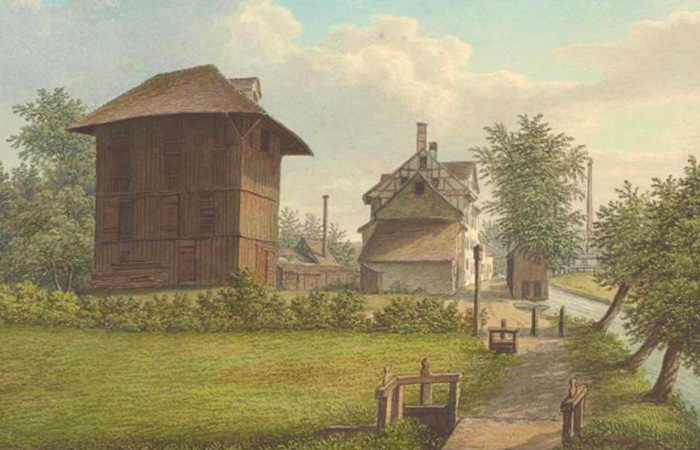
The Riehenteich with businesses, watercolour, around 1875.
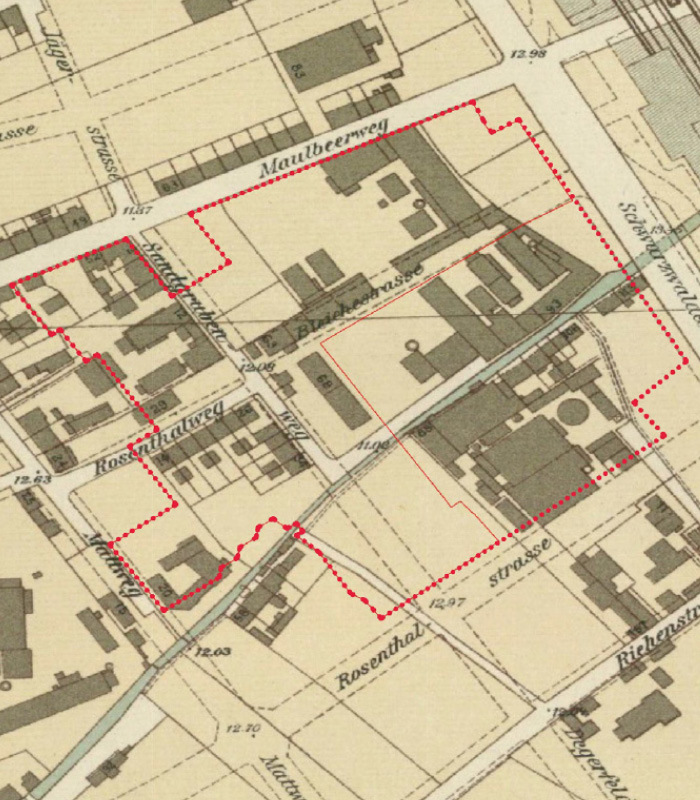
The Riehenteich and the «the birthplace of Basel's chemical industry», General plan 1905.
Thirteen years after the construction of the Farbholzmühle, 66 workers were employed in the so-called "inner factory", where both natural and synthetic aniline colors were produced. Later, the extract factory was enlarged and the factory grounds were expanded, office space and research buildings were built. In 1960, production on the Rosental site was finally stopped, the factory buildings gave way to laboratory buildings, and ten years later J.R. Geigy AG merged with Ciba to form Ciba-Geigy AG. In 1980, the original grinding and mixing building was demolished. In 1996, Ciba-Geigy AG and Sandoz merged to form Novartis, which four years later became Syngenta, headquartered in Rosental.
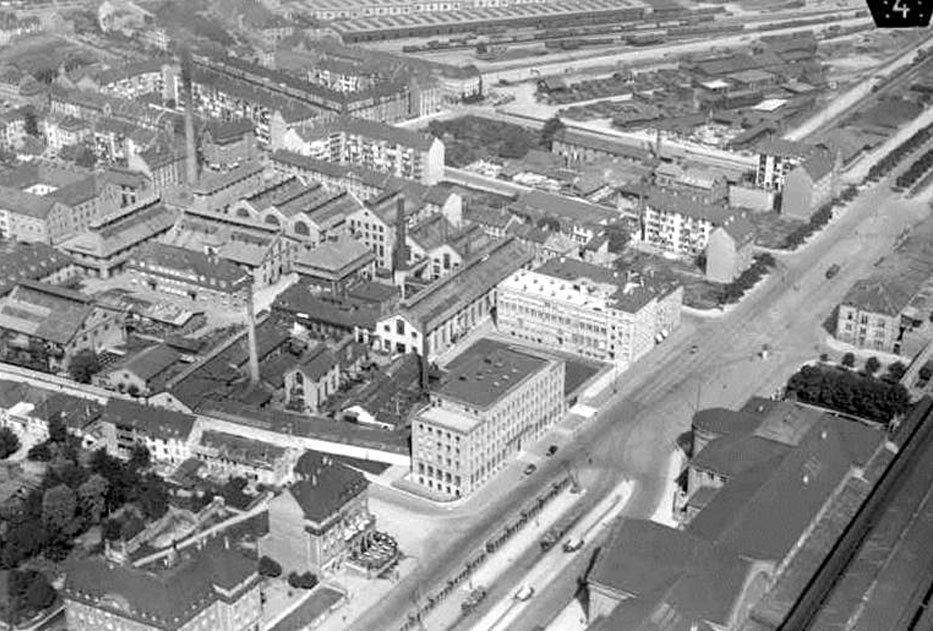
Rosental area, 1932
In 2007, the group sold a large part of the site to a private investor based in Gibraltar, only keeping its headquarters, which employs some 1,200 people from around 50 nations. The canton could purchase Rosental Mitte successively in 2016 and 2019.
1928: Switchboard operator Clara März and the development of the telephone exchange.
Clara März joined J.R. Geigy AG in 1928, initially as the only switchboard operator. When she retired in 1963 after 35 years, Geigy had a fully equipped modern telephone exchange in what was at the time one of Basel’s first high-rise buildings.
Before Clara März started working at J.R. Geigy AG in 1928, the company had already had a telephone line at the Rosental site for almost 50 years. The management took out their first phone contract in 1882, one year after the opening of the first telephone exchange in Basel. The modernisation of telephone networks soon required the establishment of a dedicated department. At J.R. Geigy, a team consisting solely of women received a constant stream of calls and connected customers from all over the world with the appropriate offices.
In the wake of the automation of telephony, the job profile of switchboard operators had changed fundamentally by the end of the 1950s. At J.R. Geigy AG specifically, it was only the internal numbers that still needed connecting manually, but at the same time there was a considerable increase in the number of calls, for which the company once again relied on more staff. In the 1950s, Geigy worked with charities for the blind to train visually impaired people as switchboard operators. The collaboration worked flawlessly and the newly trained switchboard operators soon became an indispensable workforce.
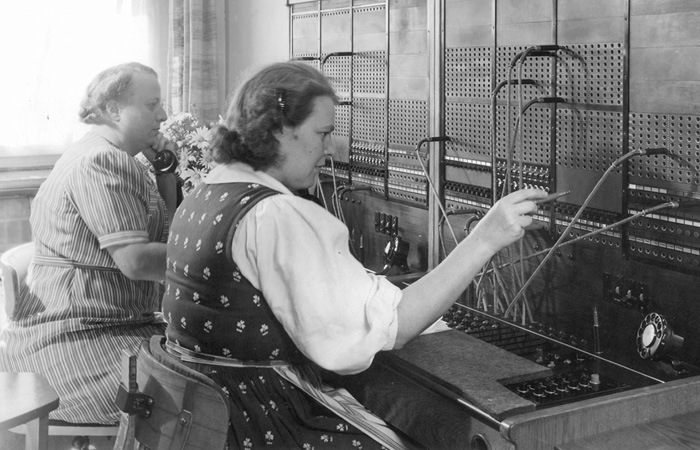
Clara März (left) and her colleague in 1948 at the switchboard control desks in the old J.R. Geigy AG administrative building. Photo from the Novartis AG company archive: courtesy of Geigy, ref. BB 9-18.
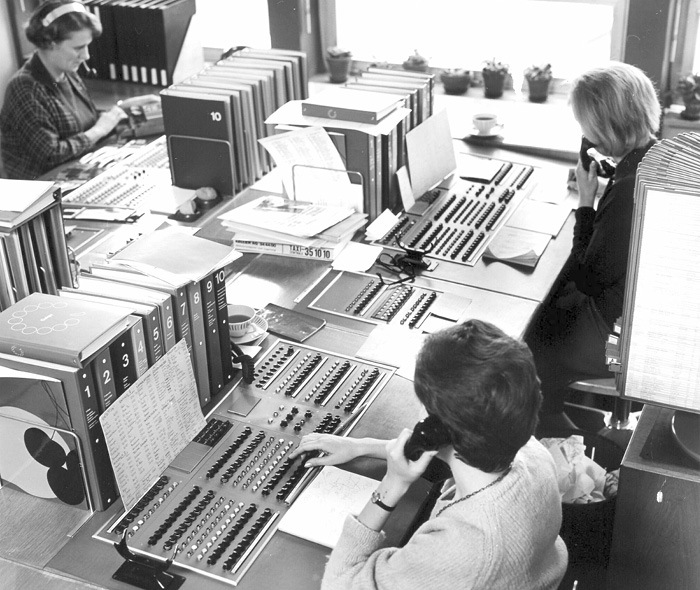
Geigy switchboard operators at the new control desks in the telephone exchange on the third floor of the high-rise building. Photo from the Novartis AG company archive: courtesy of Geigy, ref. BB 9-18.
Better working conditions or an occupation on the way out?
When Clara März retired in 1963, her colleagues at the internal telephone exchange were facing new challenges: on the third floor of the high-rise building constructed on Schwarzwaldallee in 1956, two new operator control desks were set up to be able to receive more than four calls at any one time and to minimise waiting times.
With the expansion of the telephone exchange, it was expected that the working conditions of switchboard operators would also improve. But an article in the company newspaper in 1965 pointed out that the direct dial system, which was already being used successfully in Germany, would soon also be making its way to Switzerland. In future, this would allow the company to do without the work of a large number of its switchboard operators.
Text: Lina Schmid, Büro Schürch & Koellreuter, Basel
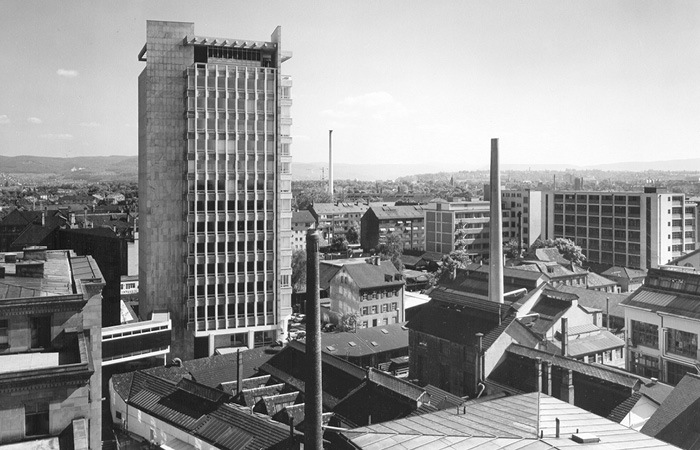
On the third floor of the high-rise building on Schwarzwaldallee, the telephone exchange was expanded with two operator control desks. The building was torn down in 2018. Photo from the Novartis AG company archive: courtesy of Geigy, ref. BB 9-4.
Hans “K.O.” Müller: an exceptional athlete.
J. R. Geigy AG began promoting company-based sports at a very early stage. One popular athlete was the 14-time Swiss boxing champion Hans Müller, who was employed at Lokal 88, a pub at the Rosental works.
Founded in 1920, the Geigy sports club was open to office and works staff and their families alike. It was set up to promote physical fitness among the workforce and foster a sense of community within the company. Netball was particularly popular with the women, while fistball and table tennis were favourites with the men. On weekday evenings, training sessions were held on the Geigy sports field, led by skilled instructors. The weekends were reserved for matches against other teams, which were also organised by the company sports club. The Geigy Sports Days, which were held annually from 1941, were always hugely popular.
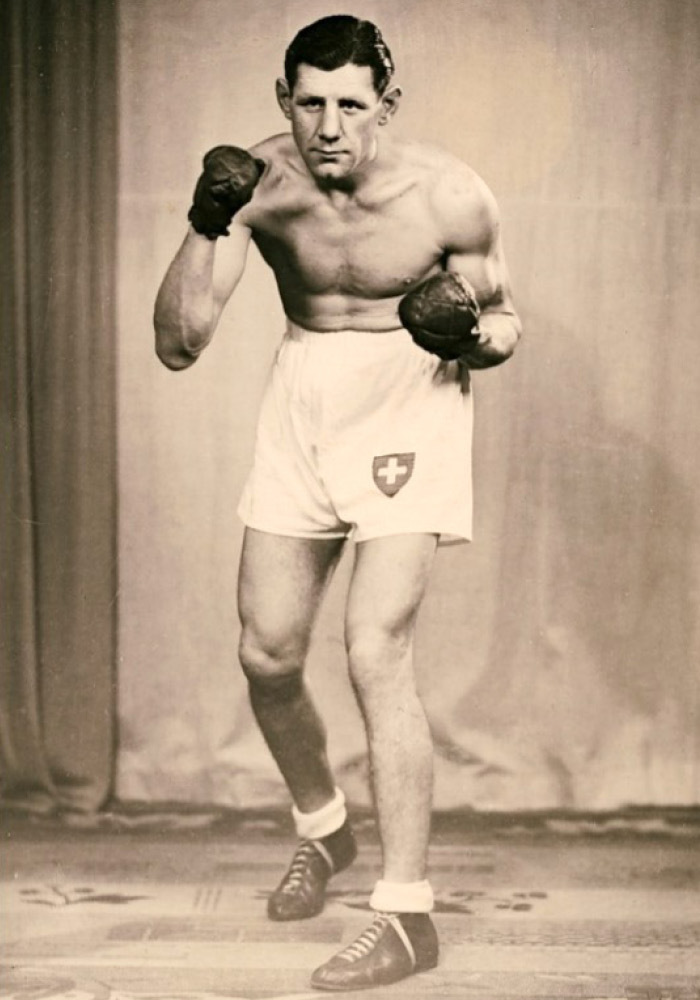
Hans Müller as a boxer. Source: Birsfelder Museum, Archive 70.393. Photographer unknown, from the estate of Fredi Salathé, Birsfelden.
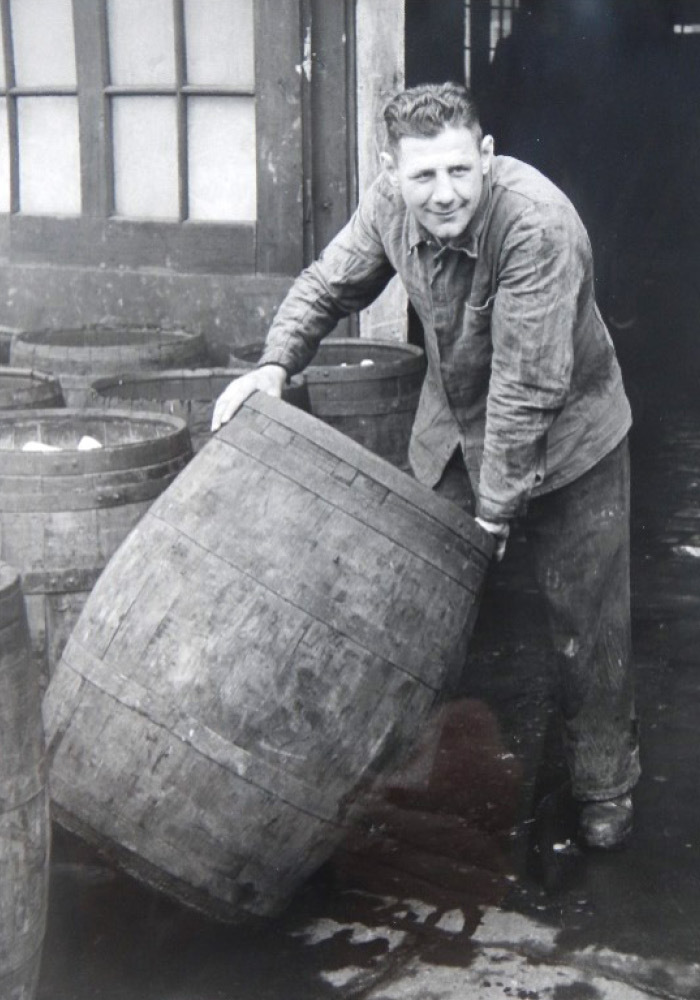
Hans Müller dressed for painting work, standing in front of Lokal 88 in Rosental. Source: company newspaper 1948, p. 231.
Hans Müller: a boxing legend
The most popular athlete from the Geigy ranks was boxer Hans Müller (1915–1967), who earned the nickname 'KO' Müller: he is said to have defeated two-thirds of his opponents with a knock-out blow. Müller, who had won the national championships 14 times by 1951, is still considered the most successful Swiss boxer of all time. He represented Switzerland at two European championships and at the 1948 Summer Olympics in London. There, however, he was beaten on points, although the Swiss press claimed that he was unjustly robbed of the victory. After the Swede Gunnar Nilsson went down in the first round, the referee allegedly started counting too late, and then counted too slowly. Nilsson was allowed to continue fighting, although he was reportedly “down for 13 seconds”, which would have meant that he was actually knocked out. Müller's fellow workers at Lokal 88 followed his Olympic fight with great excitement. After his defeat, they raised a flag of mourning out of solidarity.
J. R. Geigy AG was proud of their exceptional athlete. The company newspaper interviewed him after he took part in the Olympics. When asked about his boxing training, Müller revealed that he “had ample practice lifting heavy objects” as part of his day-to-day work at Lokal 88, and that in his free time he liked to do athletics, swim and play handball.
Text by Felix Steininger; Schürch & Koellreuter Basel
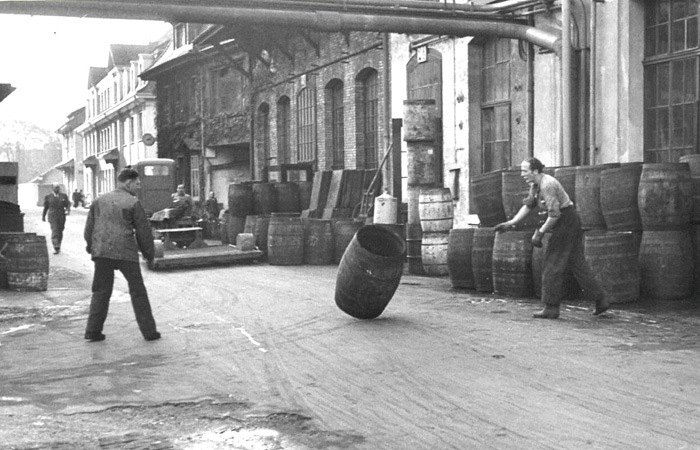
Hans Müller with a fellow worker engaged in 'rolling the barrels' in front of Lokal 88 in Rosental. Taken November 1948. Novartis Archive, BB9_15, Neg. no. 18/5210-/10-/11.
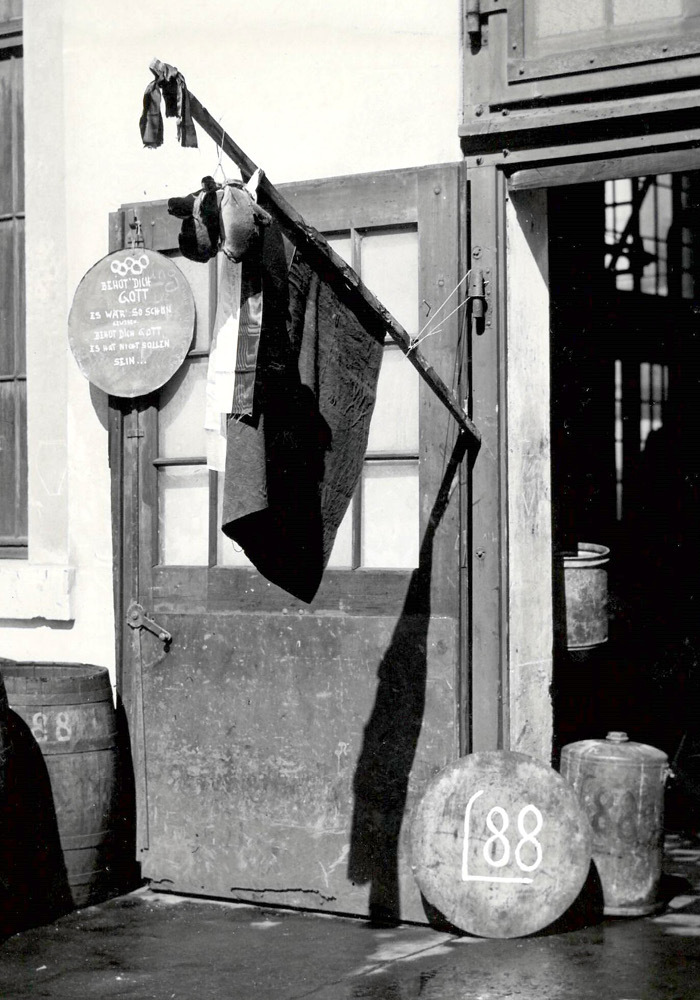
The mourning flag in front of Lokal 88, with a pair of boxing gloves. Novartis Archive, BB9_15, Neg. no. 18/5210-/10-/11.
Elsa Mühlethaler, DDT and the Nobel Prize.
The Rosental site became a research centre in the 1930s. It was here that chemist Paul Müller and his team discovered the highly potent action of DDT.
The 25-year-old Elsa Mühlethaler (1917–1998) was an exceptional figure on the Rosental site. She was the first woman to study veterinary medicine in Berne and graduate with a doctorate. When she started her job at Geigy in 1942, she was the first woman with an academic degree.
Mühlethaler’s workplace was in the ultra-modern Sandmeyer laboratory in the middle of the site. There she researched insecticides together with Paul Müller (1899–1965), who later won the Nobel Prize.
Müller, who had discovered the insecticidal efficacy of dichlorodiphenyltrichloethane (DDT) in 1939, was conducting research in the field of pest control. In 1940, the Geigy company patented DDT. Subsequently, the insecticide was widely used against everything from malaria to the Colorado potato beetle. In 1948, Müller was awarded the Nobel Prize for Medicine and Physiology. Gesarol and Neocid, the trade names of DDT used in agriculture and hygiene, were a great commercial success and triggered an agricultural revolution that could no longer function without insecticides.
In the 1950s, criticism of the highly effective poison was growing: resistance was observed, and contrary to the assumption that DDT only affected insects, larger animals were also being harmed. In 1962, Rachel Carson’s famous book "Silent Spring" was published, in which she described the consequences of the widespread and indiscriminate use of pesticides. Although she also discussed other agents, DDT was at the centre of her nightmare scenario of a spring without birdsong. The book is considered to have triggered the gradual awakening of an environmental movement.
Elsa Mühlethaler left Geigy in 1948 and in 1949 became the first woman to open a veterinary practice in Berne.
Text by Franziska Schürch; Schürch & Koellreuter Basel
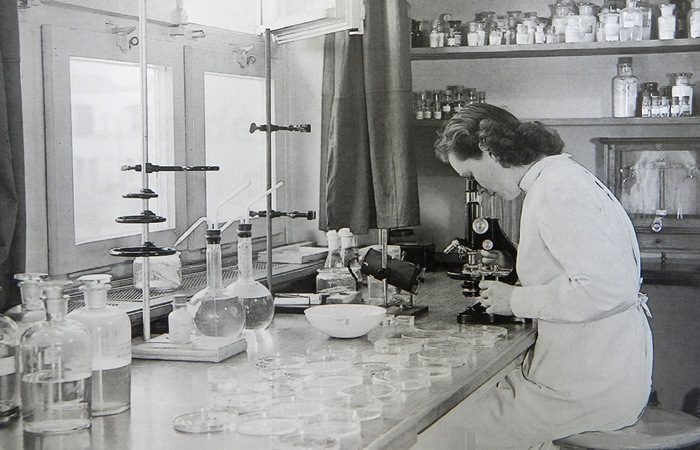
Elsa Mühlethaler in the laboratory on the Rosental site in 1947.
Novartis: Geigy collection of glass negatives, No. 13/3029
A carpentry workshop on the Rosental site.
Meaningful recreational tasks for workers.
In 1943, the company Geigy opened a carpentry workshop at the request of its workforce. Under the guidance of the master carpenters employed by Geigy, the workshop survived through a number of mergers until, in 2016, it ceased operating when it became part of Novartis.
There have been welfare institutes within Geigy since the 1870s. Yet, it wasn’t until after the Second World War that the company’s social policy saw massive expansion. Not only were there generous pension funds and occupational health insurance funds, but several institutions sprang up dedicated to increasing job satisfaction. Social initiatives such as workplace newspapers, home economics courses, sports associations, employee parties and recreational workshops all helped to bring work and private life closer together. During periods of economic boom, they were also a key way of increasing productivity in the workplace.
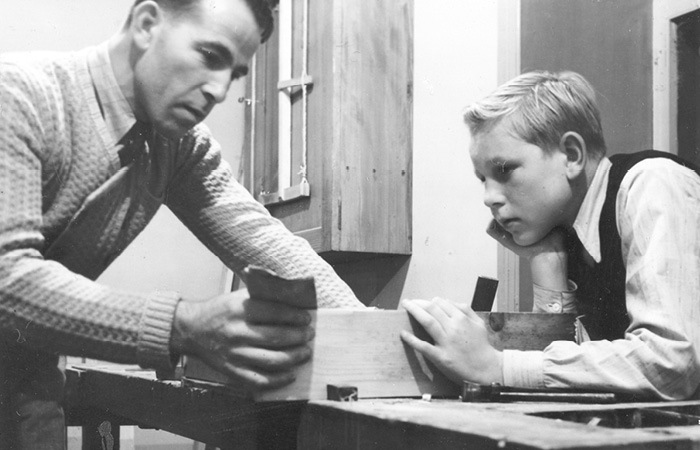
Master carpenter Alfred Gäng helps those using the recreational workshop with their projects. Novartis AG film archive: courtesy of Geigy, ref. ASS 10.
A carpentry workshop for the "Geigyaner"
For the ‘general wellbeing of the workforce’ – and at the workers’ repeated request – in December 1943 a recreational workshop was set up on the Rosental site, at Mattenstrasse 28. The workshop was equipped with six workbenches and a range of tools needed for carpentry, including a bandsaw. The workplace newspaper reported at length on the establishment of the workshop, which was accessible to all employees.
In the first few years, Geigy carpenter Alfred Gäng was responsible for operations at the recreational workshop. After he passed away in 1950, master carpenter Mr Graf took over as ‘foreman’ of the workshop. The workspace was well used – especially in the run-up to Christmas. The material for handmade Christmas presents, as well as for repairs to damaged furniture, could be acquired at cost through the in-house carpentry workshop.
In the late 1950s, the workplace newspaper praised the carpentry workshop as being perfect for establishing a balance ‘in a time of mechanisation and specialism’. According to the author of an article in the workplace newspaper in May 1957, the workshop was available to every single Geigy worker – and that included women. In 1976, after the merger with Ciba, the workshops in place within both companies were amalgamated at Ciba’s site. The ‘Freizeitwerkstatt Holz’ (the ‘recreational woodworking workshop’), as it was known, also survived the merger of Ciba-Geigy with Sandoz. It was at the end of 2016, however, that the workshop was ultimately closed – much to the disappointment of many retired former users of the workshop.
Text by Franziska Schürch; Schürch & Koellreuter Basel
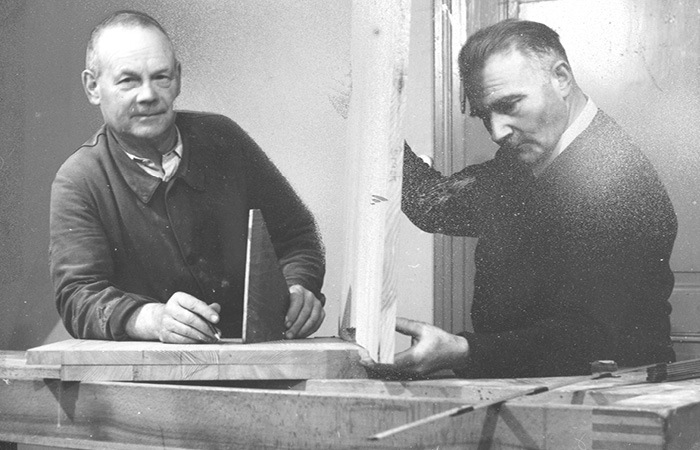
Novartis AG film archive: courtesy of Geigy, ref. ASS 10.
The ‘Rosental-Gesamtplan’ and the 1957 skyscraper.
In just 58 days, the Geigy tower, built in 1957, was taken down to make way for a new, modern administration building. But this was never built, and now a park stands in its place.
On 30 September 1956, in the presence of the Basel government and a phalanx of press, the management of Geigy AG marked the construction of its new administrative high-rise building on the Rosental site. It wasn’t the first skyscraper in Basel but, at 53 metres, it was the tallest, and it had grown inexorably upwards in the previous months. In 1957, the twelve-storey, state-of-the-art building, with an underground telephone system for 4,000 connections and a lift system with cabins for up to 13 people, was made available for use.
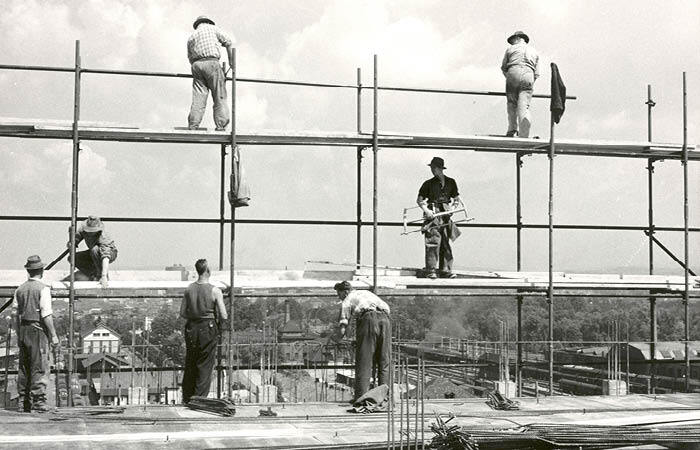
‘A skyscraper takes shape’: The construction of the skyscraper was fascinating and was documented almost in a film-like way by Geigy officials. Novartis AG film archive: courtesy of Geigy, ref. G_BB_12–2.
Space gets tight on the Rosental site
The new high-rise building was not an isolated project but part of a larger whole. Back in 1951, Geigy management had already commissioned the Basel-based architect Martin Burckhardt to develop an overall plan for the Rosental site. The company premises had been growing constantly for almost a century, and building development had expanded in line with relevant needs.
At that time of great economic growth, space on the site was getting tight and there were hardly any opportunities to extend: the company premises were almost completely surrounded by residential buildings. The overall plan was therefore intended to accommodate the largest possible volume of construction on the site to suit the organisation's needs.
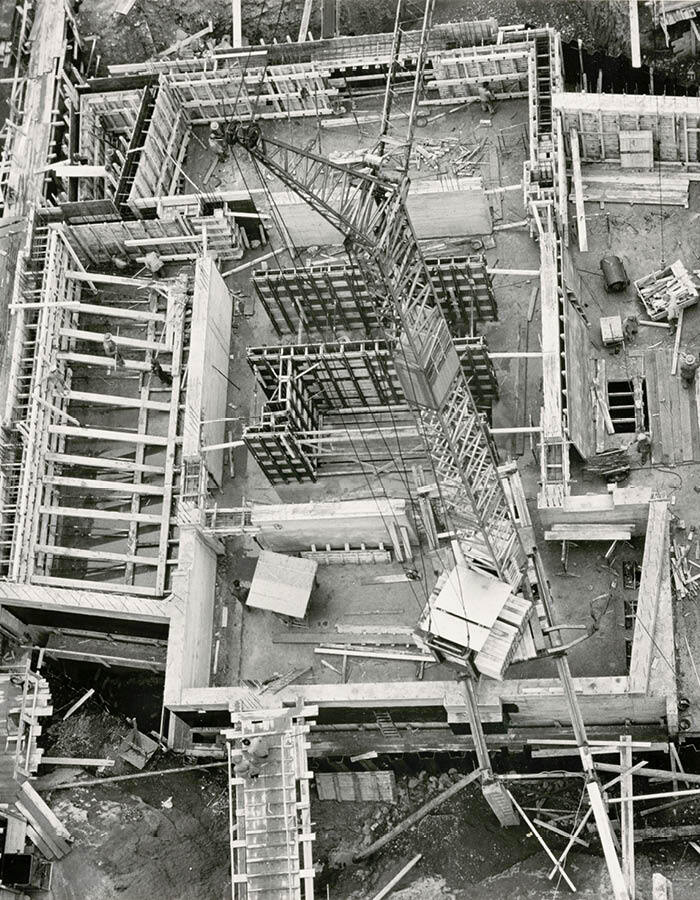
Back in 1951, Geigy management had already commissioned the Basel-based architect Martin Burckhardt to develop an overall plan for the Rosental site.
…the best solution is to reach for the sky
The overall plan launched in the winter of 1951 was to offer the best operational solutions without wasting space. The idea was to implement the plan in small stages and avoid the need for temporary arrangements. The administration was to be clearly separated from the factory and roads that were entirely within the factory’s own site were to be included in the factory premises.
In July 1953, Martin Burckhardt presented his ideas to Geigy management: he wanted to surround the site with a rectangular belt of uniform buildings, so that it appeared closed off. Inside, away from the gaze of local residents, were the factory buildings, while the outer sections were home to research and administration. For the approximately 4,000 square metres of office space needed, Burckhardt planned the high-rise on Schwarzwaldallee.
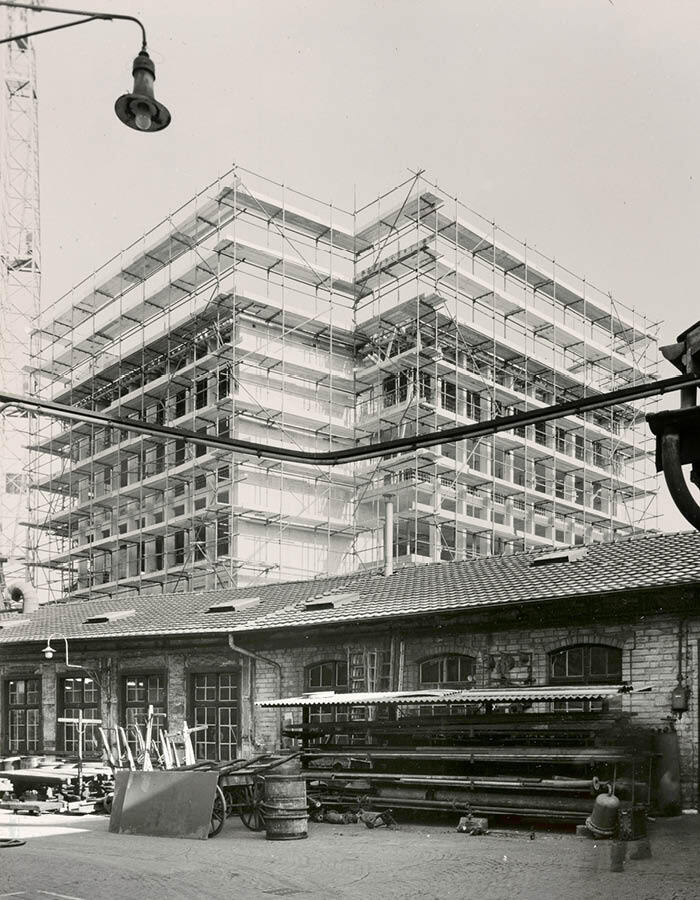
The idea was to implement the plan in small stages and avoid the need for temporary arrangements.
Still too small…
In 1960, the municipality of Basel-Stadt handed over to the company the sections of Sandgruben-, Bleiche- and Riehenteichstrasse located on the factory site so that they could be integrated into the factory premises, as intended in the overall plan. The site was then closed to the public. However, within just a few years, it ultimately became too small for a mixed use of administration, research and manufacturing. Production was relocated entirely to Schweizerhalle.
Author: Franziska Schürch, Büro Schürch & Koellreuter Basel.
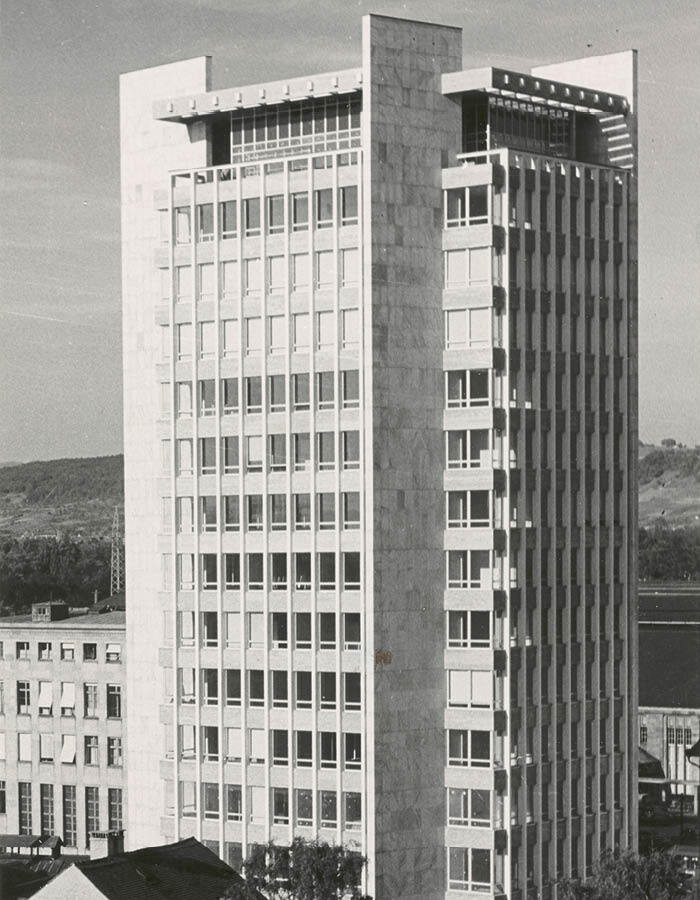
FA Novartis AG: Bestand Geigy, Signatur ASS 10.
The Sandmeyer laboratory: the birthplace of success.
In January 1941, in the middle of the war, the company Geigy celebrated the opening of the state-of-the-art Sandmeyer laboratory. As a plaque in the entrance states, the new building was dedicated to ‘Traugott Sandmeyer, the brilliant chemist,’ who died in 1922.
Dyes – Insecticides – Medicines
The period after the First World War was marked by crises for the company Geigy, which specialised in the production of textile dyes. The global economic crisis brought the fragile textile industry to a standstill, which also affected the production of dyes, Geigy’s only mainstay at the time. Under the leadership of the chemist Paul Läuger, who was appointed director in 1932, the company management therefore decided to make a fundamental change in strategy and expand its product range to include bioactive substances, medicines, disinfectants and pesticides.
In 1935, based on the experience gained with wool dyes, research was started in the field of synthetic pest control, and three years later a pharmaceutical department was set up. By 1939, 80 research and industrial chemists were already working on the Rosental site; the expansion of the product range had proved successful.
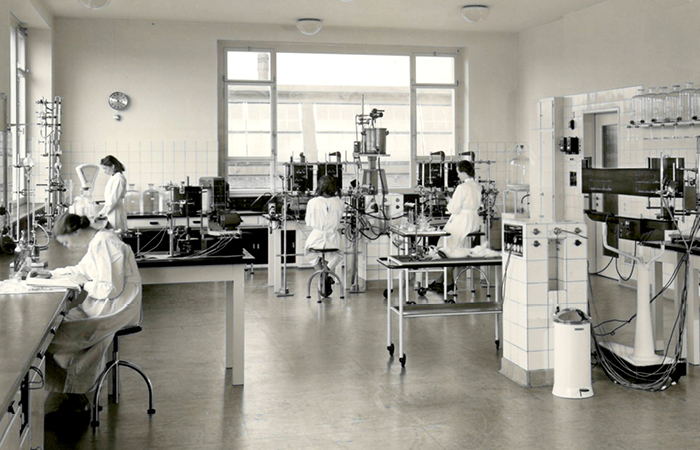
In January 1944, the Geigy company magazine published several reports on the construction of the building and gave insights into the various laboratories. The cover shows the characteristic walkway around the building, which was designed as an escape route for the laboratory staff. Novartis AG film archive: courtesy of Geigy, company magazine
A new home for new research
The new focus was reflected in the development of the site, since the existing laboratory structures were no longer sufficient. In March 1939, the Basel-based architecture company Burckhardt, Wenk & Cie. began construction of a new laboratory. The building, which was designed according to the ideas of Paul Läuger, housed the pharmaceutical and plant protection departments, as well as animal pens on the fourth floor, since the new pharmaceutical research made animal experiments necessary. A large number of new products were developed here.
The moth repellent ‘Mitin’ was launched on the market as early as 1939, and Geigy’s international breakthrough came with the insecticide DDT, which it marketed as ‘Gesarol’ from 1941 onwards. The company’s first pharmaceutical products were also launched on the market in 1942, with the disinfectant Desogen, the sleeping pill Medomin and the antibiotic Irgafen. Two blockbuster drugs from Geigy were created in this laboratory building: the antidepressant Imirpamin (1958) and the anti-inflammatory drug Voltaren (1960s).
In April 1999, the Sandmeyer laboratory was demolished. The plaque with the reference to Traugott Sandmeyer survived and is now located in front of building 1080, in memory of a self-taught researcher who made numerous discoveries in the synthesis of dyes, and whose work laid the foundation for the upswing of the dye industry in Basel and around the world. The plaque also serves as a reminder of a building that represents a turning point in the history of Geigy: a gradual shift away from the dye industry towards agrochemicals and pharmaceuticals.
Franziska Schürch, Schürch & Koellreuter, Basel
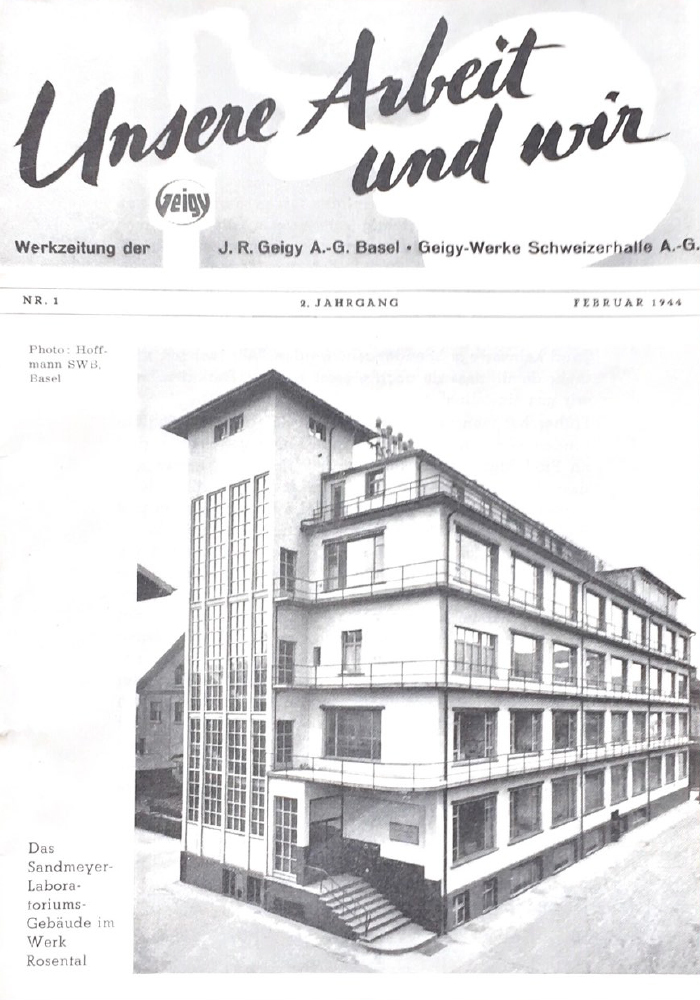
During the construction of the laboratory, care was taken to ensure that there was plenty of natural light thanks to the largest possible windows. The picture from 1945 shows the pharmacological laboratory where, in the centre of the room, an animal experiment was being carried out on a rabbit. Novartis AG film archive: courtesy of Geigy, ref. BB_9–13, photo by Spreng.
Lokal 68 – the history of a production building.
Until 1966, the location of what is now the Friedrich Miescher Institute was home to ‘Lokal 68’, a production building for paint and intermediates. It was located on the north-eastern edge of the Rosental site and shared a direct border with Maulbeerstrasse on its rear side.
Lokal 68 was built in 1916, right in the middle of the First World War. Shortly beforehand, Geigy had purchased plot 921 with the idea of enlarging the production site to expand and modernise the production of intermediate products and dyes on the Rosental site. The new production building was ready for occupation in January 1917. The years between 1916 and 1920 saw the construction of 23 new buildings on the Rosental site. The reason for the factory’s expansion was the war: Geigy had been producing a large proportion of synthetic paints in Grenzach, Baden, since 1898.
The outbreak of war disrupted work with the plant in Germany, even forcing it to close in May 1917. At the same time, the war had increased the demand for dyes: many armies were swapping their colourful uniforms for ones in field grey or field green. Germany, which had been the world’s largest paint producer up until that point, was largely excluded from global trade, meaning that orders often went to Basel.
In Switzerland, too, the Federal Council decided in 1914 to change the Swiss military cloth to field grey using Eriochromverdon S, which was produced by the Geigy company, amongst others. To meet this increased demand, the Basel factory had to be expanded.
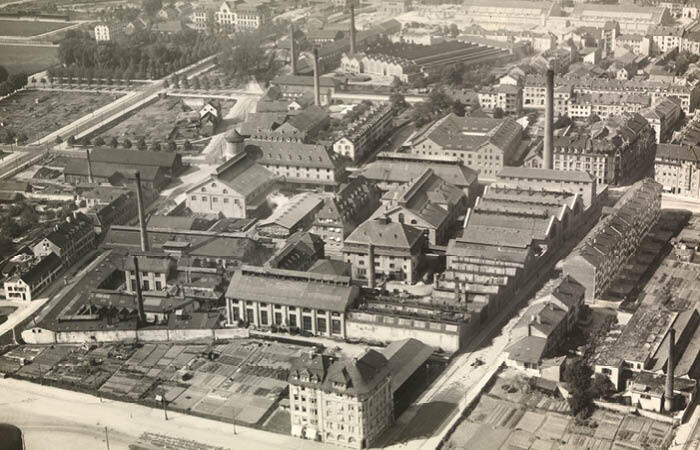
The aerial photograph by Walter Mittelholzer shows the Rosental site as seen from Badischer Bahnhof around 1924, following the expansion phase between 1916 and 1920. Lokal 68, a production building with three gables, borders Maulbeerstrasse. The steam room with its high chimney stands just behind it, towards Sandgrubenstrasse. Image credit: ETH Bibliothek Zurich, Image archive/Stiftung Luftbild Schweiz / Photographer: Mittelholzer, Walter / LBS_MH03–1437 / Public Domain Mark
Lokal 68 hosted the production of azo dyes, i.e. cotton and wool dyes – not in field grey, but blue and black – as well as various acids. The starting material for azo dyes is the aniline obtained from coal tar, hence the name tar or aniline dyes. The paint production work was physically strenuous, dirty and, above all, unhealthy. Depending on the workload, Lokal 68 employed between 15 and 40 men, many of whom were unskilled auxiliary workers who gained further qualifications within Geigy over the years. One of them was Karl Beck, who joined the Geigy company aged 23 as an unskilled worker in 1926; he did not have an apprenticeship as a paint worker. After a few years at Lokal 68, he was able to work his way up: first as an assistant stoker, then from 1942 onwards, to a stoker in the Geigy energy centre. On his 40th work anniversary, Beck was given a portrait in the factory newspaper in 1966.
In 1949, Local 68 was expanded into a new ice cream factory. When Geigy stopped production on the Rosental site in the 1960s and relocated it to Schweizerhalle, numerous factory buildings were demolished, including Lokal 68, in 1966. The plot initially remained undeveloped. In 1970, following the merger of Ciba and Geigy, the Friedrich Miescher Institute, the private research institute for basic research in the field of molecular biology founded by the two companies, was built here.
Franziska Schürch, Schürch & Koellreuter, Basel
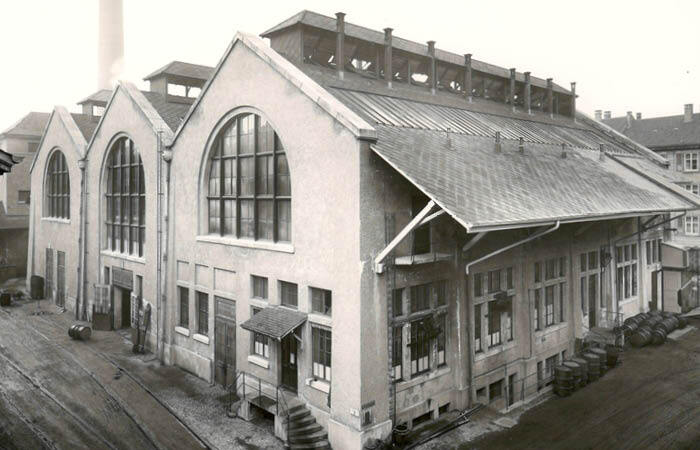
Lokal 68 shortly after its completion in 1921. The connection of the new building to the rail network, also newly laid at the time, can be seen here.
How Geigy came to the Amsterdam Art Museum.
In 1962, Geigy caused a minor sensation: for the first time, corporate advertising was exhibited in a European art museum, in Amsterdam. Under the title ‘Design for Industry,’ posters and packaging from the ‘Container Corporation of America’ and a Dutch print shop were presented alongside the advertising products of the Basel-based company. The works of the chemical company were regarded as outstanding, as they skilfully combined sophisticated, modern design with a commercial message. This was no easy task, as the advertised products were not familiar everyday objects. The Group’s graphics department succeeded in translating the abstract into a visually comprehensible form. What became known in graphic circles in Europe and North America as Swiss Style or Swiss Design in the 1960s was closely linked to the development of Geigy graphics.
Founding of the Geigy Atelier
The beginnings of Geigy graphics date back to the period of economic recovery and the spirit of optimism after the end of the Second World War. As a branch of the propaganda department founded in 1941, the so-called Geigy Atelier was established on the Rosental site in 1947. Whereas previous work had been outsourced to external graphic designers, the aim now was to develop a recognisable style. The director was artist and graphic designer Max Schmid. At the same time, his former colleague and good friend Armin Hofmann was appointed specialist teacher for graphic design at the Allgemeine Gewerbeschule Basel.
Their professional and personal collaboration meant that over the next two decades or so, graduates of the Basel graphic design class were able to gain their first professional experience at the Geigy Atelier. This resulted in a high level of design continuity. After all, anyone who had studied under Hofmann was experienced in the search for pictorial symbols and concise typography. They understood the unity of form, colour and text and knew the basics of composition. And despite this continuity, Geigy graphics remained fresh thanks to the steady stream of young graphic designers with their ideas and inspirations.
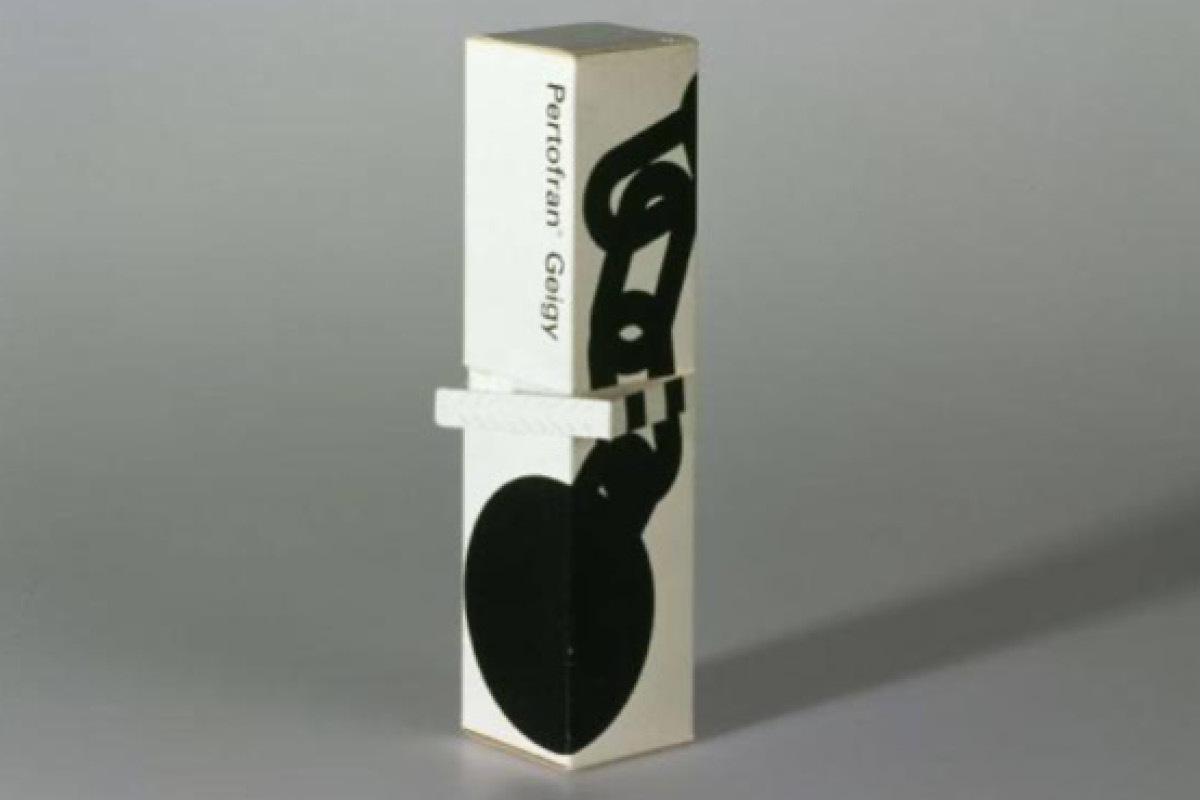
Petrofran: packaging by Max Schmid, 1962 and 1965.
An abstract iron ball with an anklet is the image Max Schmid uses for psychological suffering. The Geigy preparation Petrofran promises relief. The image is used for stationery, advertising brochures and packaging. When the box is opened, the heavy chain is severed.
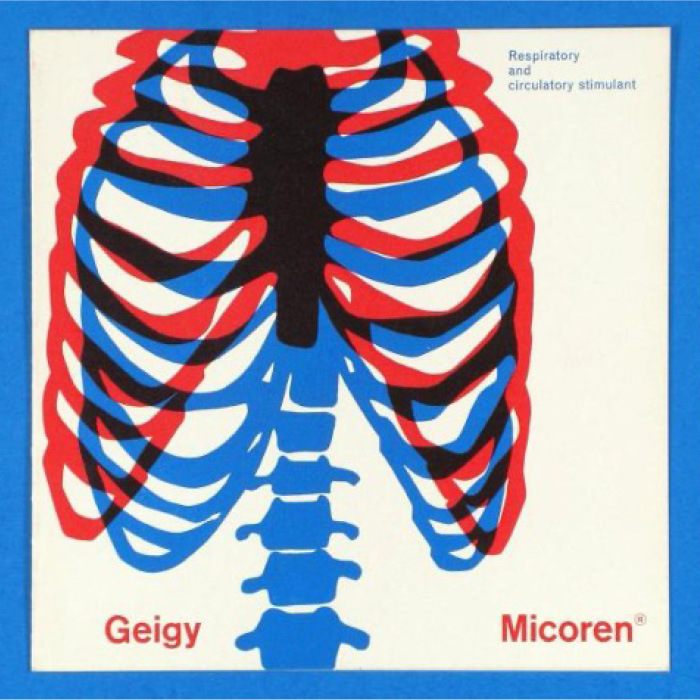
Therese Moll: Advertising card for Micoren, a stimulant for the respiratory center, 1957
After completing her training in Basel, the young graphic designer first went to Milan and later worked for Karl Gerstner. In 1957, she joined the Geigy studio, where she set new accents with her work. In 1959, she was invited to the Massachusetts Institute of Technology (MIT) as a guest graphic designer in its own studio, where she was involved in teaching the basics of European typography and the design of modular systems. In this way, she contributes to the reputation of Swiss design.
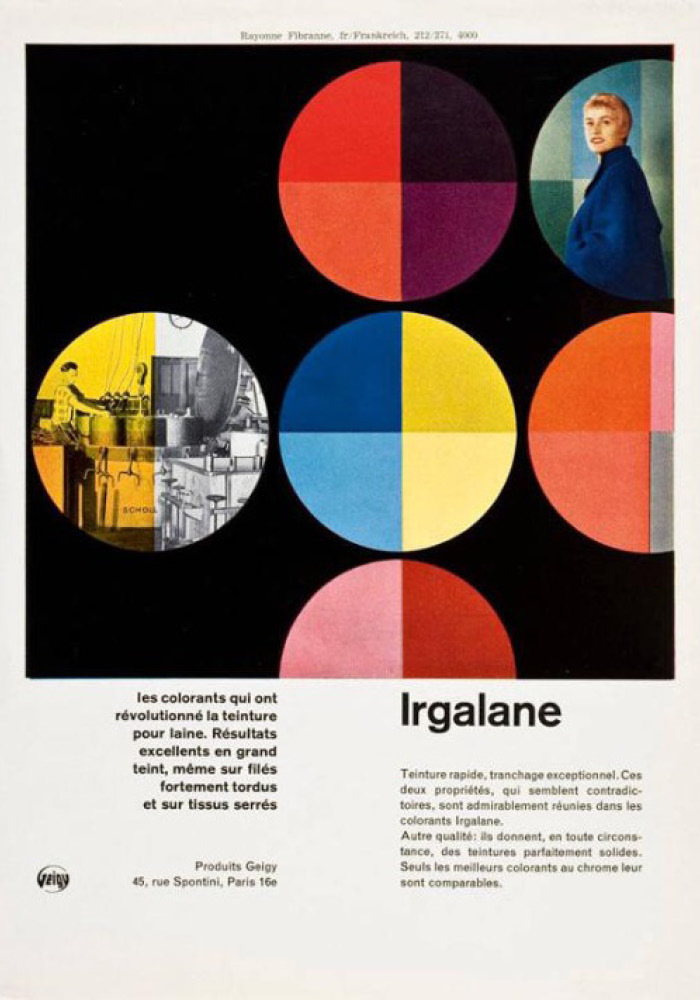
Dye advertisements by Karl Gerstner, 1953.
The sentence was changed for the different languages. With his designs, Gerstner, who was one of the first to come to the Geigy Atelier in 1949, made a major contribution to the development of the Geigy style. This stood for visual and content clarity, symbolic abstraction and functionality.
International recognition
The Geigy Atelier was thriving: the graphic designers and typographers were joined by decorators, printers, academic administrators, editors and proofreaders. Not only were posters and packaging produced, but also exhibitions, films and magazines. The propaganda products were translated into more than ten languages. Soon, design was also underway outside Basel: Max Schmid travelled to New York and worked for the Geigy branch in Ardsley. Graduates of the graphic design class in Basel also continued to develop the Geigy style in the UK, Spain, Italy, Canada and Australia. Geigy’s many products – pharmaceuticals, pesticides, insecticides and dyes – that were available worldwide also contributed to the wider distribution of the Geigy style.
The packaging, advertisements and propaganda publications were discussed in trade journals, usually under the labels Schweizer Grafik, Swiss Design or Swiss Style. In 1967, a series of exhibitions on modern graphics opened in Princeton featuring ‘Geigy Graphics’. The more than 50 designers who had worked in the Geigy Atelier for several years moved on, thus contributing to the spread of this special style. And so, the graphic design department on the Rosental site was regarded as the launch pad for a magical moment in Swiss graphic design of the 1950s and 1960s.
Isabel Koellreuter, Büro Schürch & Koellreuter
Further literature
Dorothea Hofmann: The birth of a style. The impact of the Basel education model on Swiss graphic design. Zurich 2016.
Museum für Gestaltung Zürich, Andres Janser, Barbara Junod (eds.): Corporate diversity. Swiss graphic design and advertising for Geigy 1940–1970. Zurich 2009.
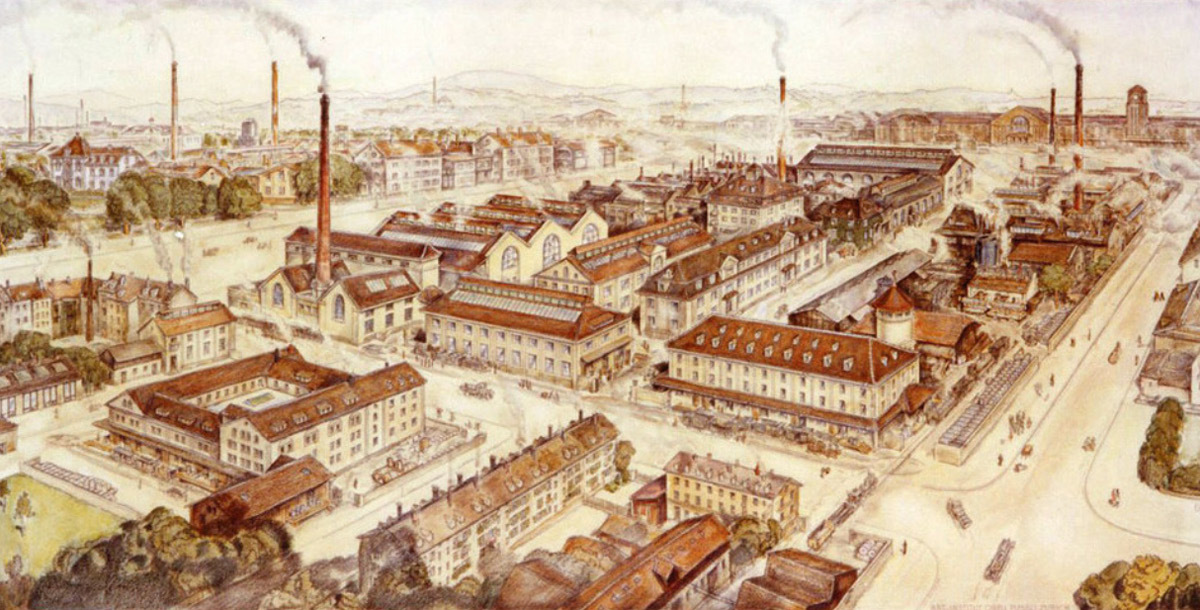
J. R. Geigy AG company site, colour lithograph, 1926.